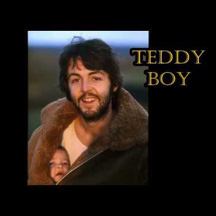TEDDY BOY (The Beatles)
“Teddy Boy” is a song by Paul McCartney and was first released on his first solo album McCartney, released in April 1970 after the Beatles disbanded. According to Paul McCartney in the documentary Wingspan, he wrote this song for the Beatles’ Let It Be sessions; but due to tension in the group at the time, nobody had the patience to work with it. Still, the Beatles recorded the song 6 times in January 1969, at their Apple Studios in London. A composite version made of two of these recordings was released in 1996 on the Anthology 3 album. (More from Wikipedia)
Not long after I first got to college at North Carolina State University (probably in late 1969), one of the big record stores in Raleigh, the Record Bar (which was within walking distance of the campus) had several tables set up in the middle of the store that were piled high with bootleg albums. I had never heard of such a thing before, so I snapped up four right away, including Kum Back by the Beatles (practice sessions for the Let it Be album for the most part, sounds like, and including an 8- or 9-minute version of “Teddy Boy” – that song was originally going to be on Let it Be; but instead, “Teddy Boy” is on Paul McCartney’s solo album McCartney).
(April 2012)
* * *
One thing about Kum Back that I didn’t particularly like was the seemingly endless performance of “Teddy Boy”; unlike most of the songs on the album that became part of the Beatles’ Let it Be album, “Teddy Boy” was instead released as a song on Paul McCartney’s first solo album, McCartney – this album actually came out in April 1970, the month before Let it Be. (McCartney is not the first solo album by a Beatle though; Wonderwall Music, a soundtrack album of Indian classical music for a film called Wonderwall, was released in November 1968 by George Harrison).
At nearly 6 minutes in length and almost 2 minutes longer than any of the other songs on Kum Back (according to the Wikipedia article), “Teddy Boy” seems even longer; while there are two verses, the song mostly consists of the chorus line – “He said, Mommy don’t worry, now Teddy boy’s here / Taking good care of you” – repeated multiple times with very minor wording changes.
* * *
As to the tracks on Kum Back that did not show up on Let it Be, besides “Teddy Boy”, a performance for just under a minute of a blues song by Jimmy McCracklin called “The Walk” (also known as “Can He Walk”) also does not appear on Let it Be. The biggest surprise though is that one of the strongest songs made by the Beatles in their twilight years, “Don’t Let Me Down” – previously released in April 1969 as the b-side of the “Get Back” single – was also not included on Let it Be, though it was among the songs in the 2003 reissue, Let it Be . . . Naked. With the inclusion of “Don’t Let Me Down”, two short tracks, “Dig It” and “Maggie Mae” (not the same song as the Rod Stewart classic, “Maggie May”) were left off Let it Be . . . Naked. Together, these two songs run just 1:30; honestly, you’d think there would be enough room on the CD for them, too (neither appears on Kum Back either, though “Don’t Let Me Down” does).
Anthology 3 includes numerous Beatles tracks from the Let it Be sessions that (as I remember) are likely the corresponding songs on Kum Back; in all, 12 of the 23 songs on the second CD are identified in Wikipedia as “Savile Row Sessions”, with recording dates ranging from January 22 through January 29, 1969. Among these songs are “Teddy Boy”, but with a much shorter running time of 3:18. Other performances on Anthology 3 from the Savile Row Sessions that have no connection to the Let it Be album are two of the Abbey Road songs, “She Came In Through the Bathroom Window” and “Oh! Darling”; a song called “Mailman, Bring Me No More Blues” that had been recorded by Buddy Holly in 1957 and was part of the Beatles’ live repertoire until 1962; and a medley of three rock and roll classics – “Rip It Up”, “Shake, Rattle and Roll” and “Blue Suede Shoes”.
(September 2017)















